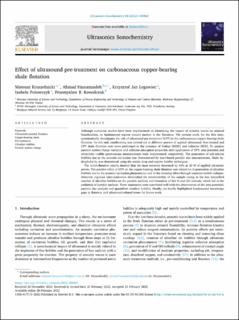| dc.description.abstract | Although numerous studies have been implemented on identifying the impact of acoustic waves on mineral beneficiation, its fundamental aspects remain unclear in the literature. The present work, for the first time, systematically investigates the role of ultrasound pre-treatment (UPT) in the carbonaceous copper-bearing shale flotation. To this end, conditioning was carried out at different powers of applied ultrasound. Non-treated and UPT shale flotation tests were performed in the presence of frother (MIBC) and collector (KEX). To analyse particle surface charge variation and collector adsorption properties after application of UPT, zeta potential and ultraviolet–visible spectroscopy measurements were implemented, respectively. The generation of sub-micron bubbles due to the acoustic cavitation was characterised by laser-based particle size measurements. Shale hydrophobicity was determined using the sessile drop and captive bubble techniques.
The micro-flotation results showed that the mass recovery increased by 40% at 20 W of applied ultrasonic power. The positive effect of UPT on the copper-bearing shale flotation was related to: i) generation of ultrafine bubbles due to the acoustic cavitation phenomenon and ii) the cleaning effect through transient bubble collapse. However, rigorous ultra-sonication diminished the recoverability of the sample owing to the less intensified number of ultrafine bubbles on the particle surfaces and formation of free H and OH radicals, which led to the oxidation of particle surfaces. These statements were correlated well with the observations of the zeta potential, particle size analysis and quantified ultrafine bubbles. Finally, we briefly highlighted fundamental knowledge gaps in flotation and ultrasound-related issues for future work. | en_US |

